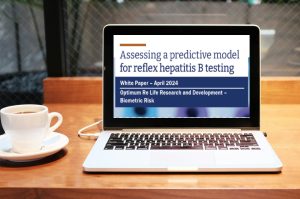At the recent Association of Home Office Underwriters (AHOU) meeting, Executive Vice President, Betsy Sears, shared insight that our data analytics team has collected and analyzed comparing self-disclosure to positive confirmations of various laboratory tests. Our insurance clients tell us consistently that fraud is a top concern – whether intentional or unintentional applicant nondisclosure, it can cost companies millions.

Since not everyone could join us at AHOU, we wanted to share a few highlights from Betsy’s presentation. Here are 3 stats that our recent study uncovered about the life insurance population.
- Five percent of applicants understate their weight by more than 25 pounds. It’s been known individuals sometimes may stretch the truth on their driver’s license when it comes to updating their weight number. Some believe they still weigh the same as they did at age 16 when they first completed the “weight” box at their local DMV. When it comes to applying for life insurance, are these people a little more truthful? The answer is not entirely. We recently studied the results of more than 40,000 applicants. An astounding 20.7% of individuals whose BMI was more than 30, stated a normal build class (BMI under 30) during the application.
- Tobacco nondisclosure involves knowingly omitting this information. Above I stated that there is intentional and unintentional nondisclosure. When it comes to tobacco, it’s a fairly safe assumption to say an individual knows if he or she smokes. It’s a term commonly referred to as “smoker’s amnesia” when a person conveniently forgets about his or her smoking use. In our study, 23% of individuals who tested positive for cotinine, denied tobacco use at the time of the application. If an individual knows an exam will not be completed, their tobacco use will not be confirmed. This allows them to receive the same rates as a non-smoker while carrying roughly twice the mortality risk.
Present value of premium savings from avoiding a smoker classification in 20-year term policies:
20 year-old female, $100,000 face amount: $180
60 year-old male, $1 million face amount: $50,000
- New hepatitis C (Hep C) infections have nearly tripled since 2010. According to Quest Diagnostics, Hep C is a silent disease because symptoms can take decades to develop. More than 3 million people in the United States have a chronic Hep C virus infection but are not aware because they do not look or feel sick. Our team discovered 77% of applicants who tested positive for Hep C did not disclose during the application. It is possible many of these individuals did not know of their existing condition prior to receiving their laboratory results.
Final thoughts
Each of the above conditions can contribute to other health-related diseases such as heart disease, stroke and cancer – all of which can have serious mortality implications. We invite you to join us for our upcoming webinar where Betsy Sears will reveal more hidden truths that are omitted from the life insurance application and how you can protect your bottom line.





















At the recent Association of Home Office Underwriters (AHOU) meeting, Executive Vice President, Betsy Sears, shared insight that our data analytics team has collected and analyzed comparing self-disclosure to positive confirmations of various laboratory tests. Our insurance clients tell us consistently that fraud is a top concern – whether intentional or unintentional applicant nondisclosure, it can cost companies millions.
Since not everyone could join us at AHOU, we wanted to share a few highlights from Betsy’s presentation. Here are 3 stats that our recent study uncovered about the life insurance population.
Present value of premium savings from avoiding a smoker classification in 20-year term policies:
20 year-old female, $100,000 face amount: $180
60 year-old male, $1 million face amount: $50,000
Final thoughts
Each of the above conditions can contribute to other health-related diseases such as heart disease, stroke and cancer – all of which can have serious mortality implications. We invite you to join us for our upcoming webinar where Betsy Sears will reveal more hidden truths that are omitted from the life insurance application and how you can protect your bottom line.